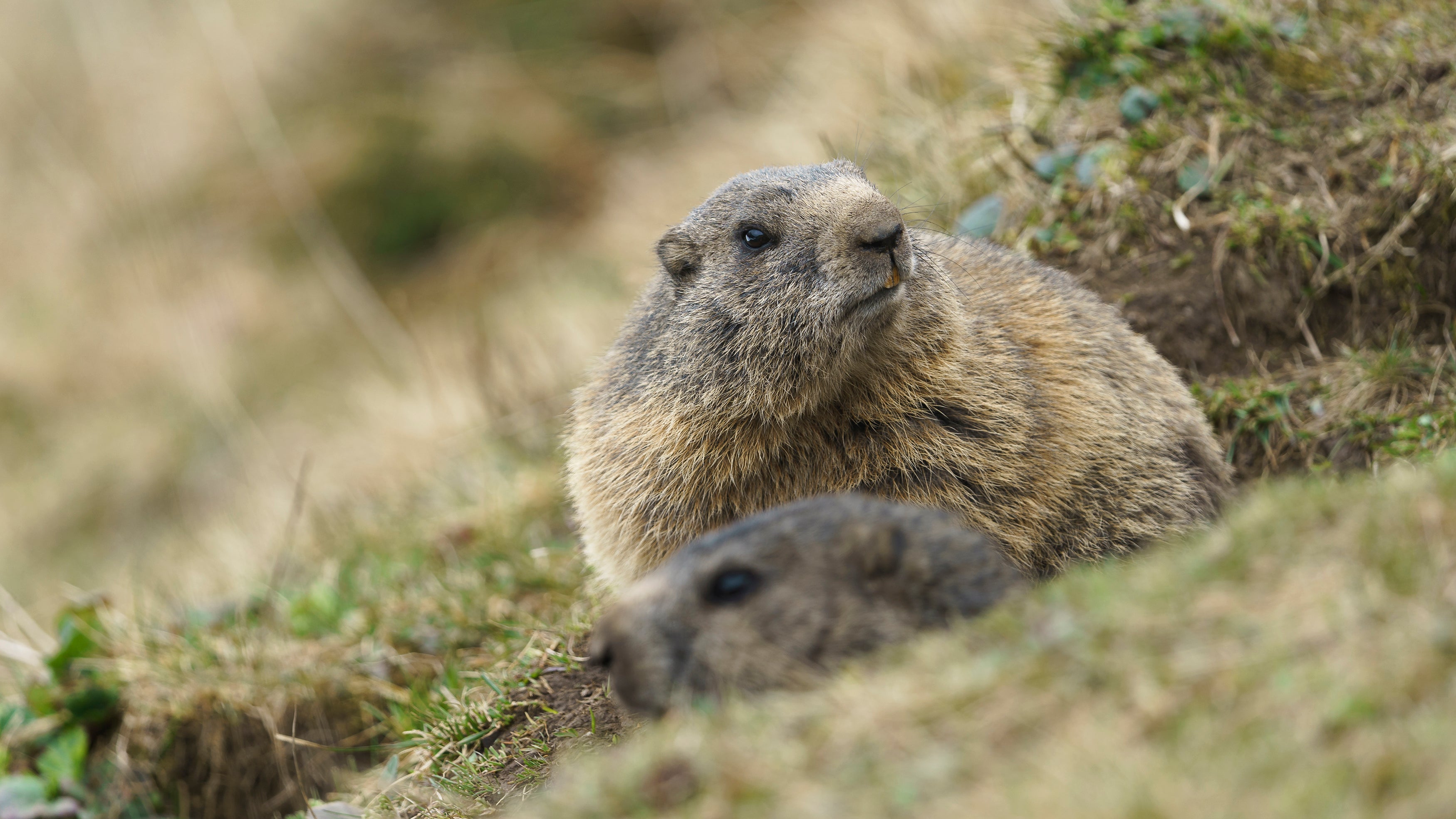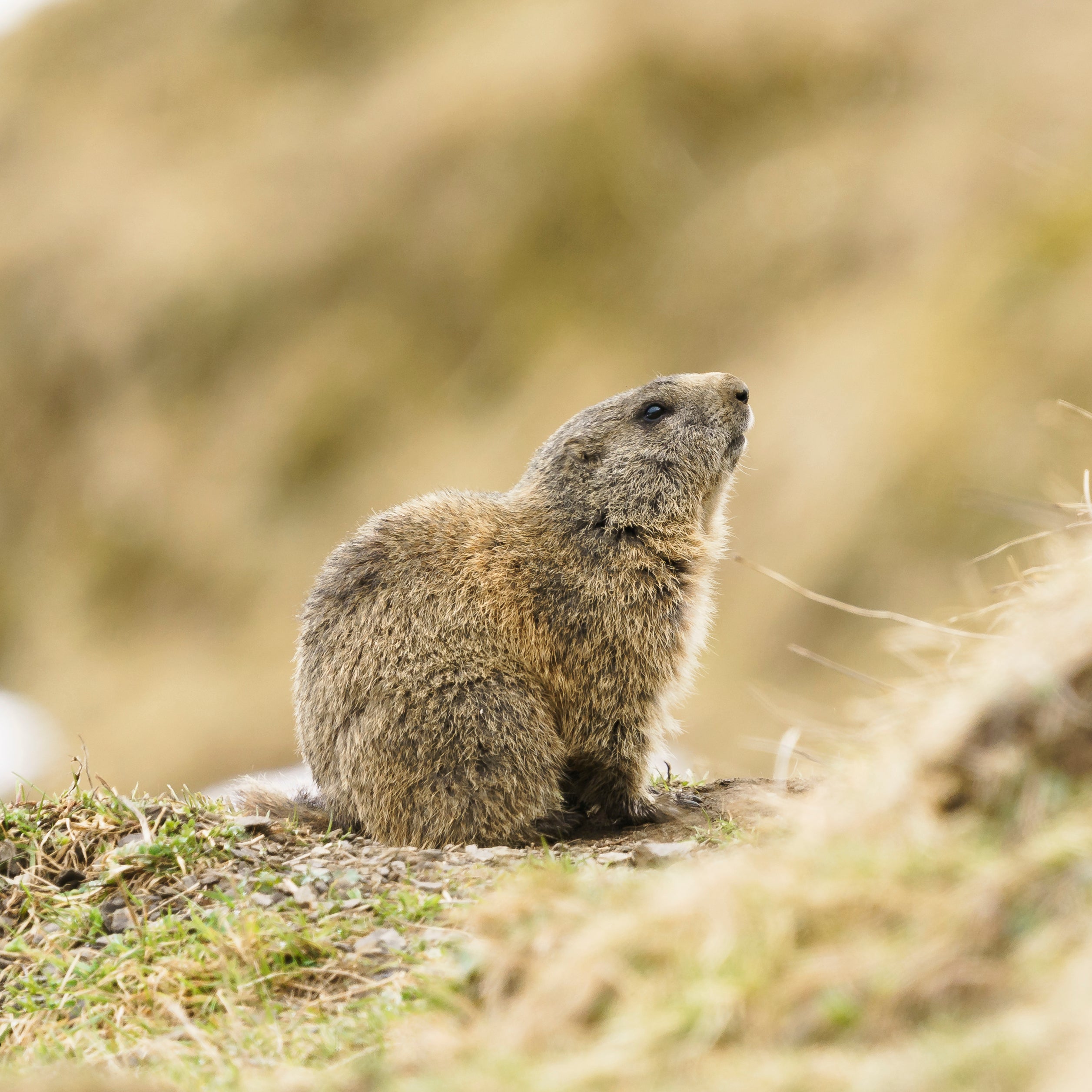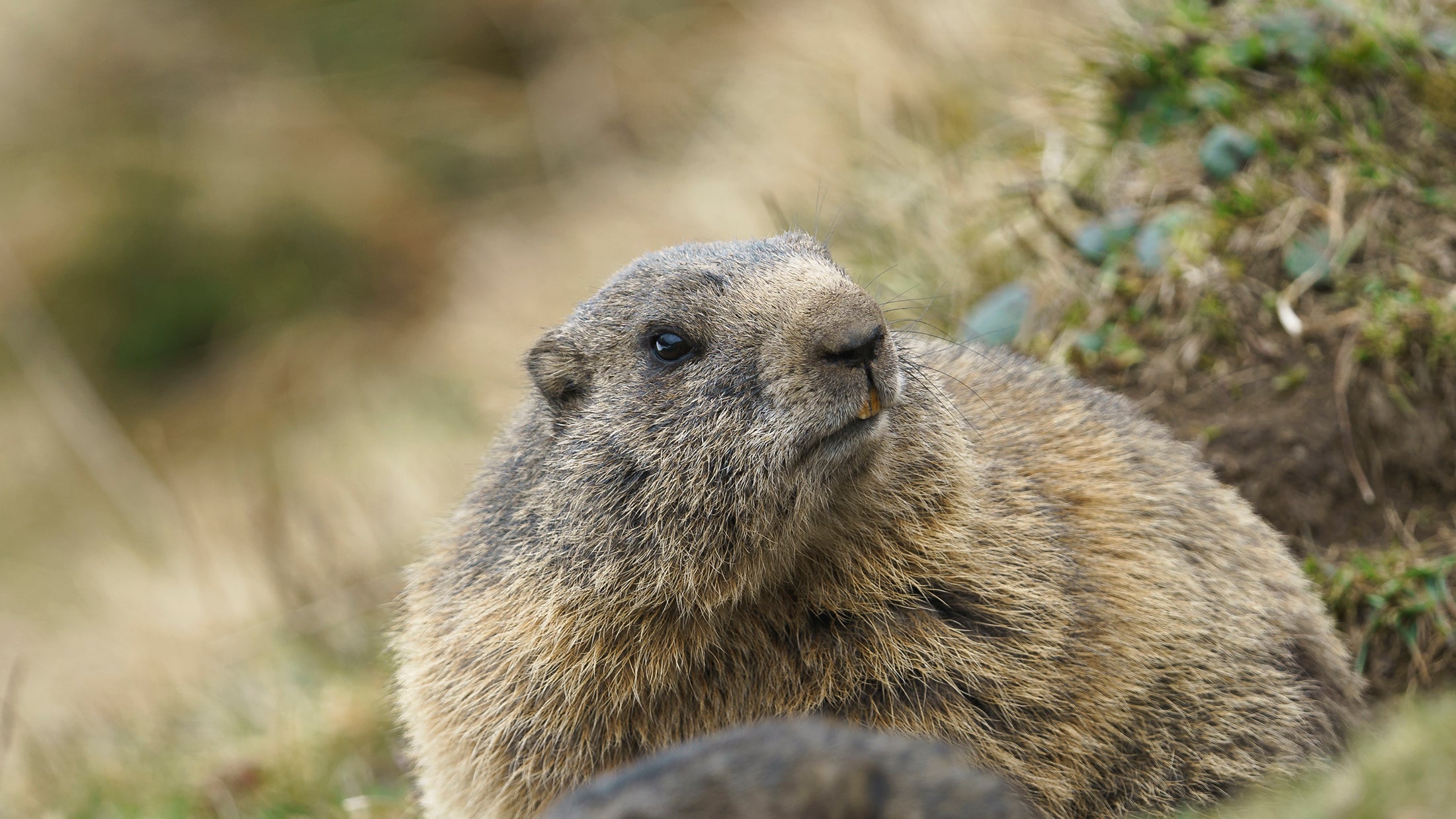Marmots
Our cute Alpine inhabitants
Anyone who thinks that marmots sleep continuously throughout the winter is wrong. Here you can find out lots of exciting things about our shy Alpine inhabitants.
A clear case of think again
If you spend a lot of time in the mountains, you have a good chance of seeing marmots . They are particularly easy to observe in summer, when the cute alpine inhabitants rest on the rocks.
Do you think that marmots like to sunbathe? You're wrong. Marmots seek cooling, not warmth, on the rocks. And we often talk about the animals' shrill whistling. But no, the supposed whistling is actually a scream.
There is so much to tell about marmots. Read on 😊.
Origin and distribution
Originally native to the vast steppes, marmots settled in the mountains after the Alpine glaciers retreated. They followed the cold-resistant grasses and herbs up into the heights and found their suitable habitat above the tree line.
There are fifteen species of marmot. They all live in the northern hemisphere. The Alpine marmot (Marmota marmota) is now found across the entire Alpine arc. After marmots were largely eradicated in many places, they were reintroduced 150 years ago in the Pyrenees, the French Massif Central, the Apennines, the Vosges, the Swiss Jura, the Black Forest, the Slovenian Alps, the Romanian Carpathians and the Tatra Mountains (Slovakia, Poland). Marmots prefer treeless grassland or grassland with few trees and bushes.
Where does the name come from
Murmeli, Mungg, Marmotte, Murmende, Murmetli, Mankei – the marmot has numerous names. The origin is found in the Latin "Mus Montis" (mountain mouse). This is said to have become "Murmont" in Romansh. In Old High German it was then "Murmenti", which is very close to the current name. "Marmot" in English or "Marmotte" in French are closely related to it. In hunting language, the male marmot is called "bear", the female "cat" and the young "monkey".
Profile
The Alpine marmot (Marmota marmota) is the largest rodent in the Alps after the beaver.
belongs to the family of squirrels . In contrast to the tree squirrels (e.g. squirrels), the
Marmots Ground squirrels.
The marmots' bodies appear somewhat stocky and bulky. Marmots have a short, round head with small ears that are almost hidden in their fur and very pronounced whiskers. They have strong limbs with blunt digging claws on their feet. The whole body is very agile. The outer enamel layer of the strong incisors is brownish-orange in color.
The basic colors of the fur range from slate gray to reddish yellow. The top of the head is blackish, the muzzle is light and the back is dark. Young animals up to two years old have less contrasting colors.
Size and weight
Head-body length: 45 to 5cm
Tail length: 14 to 2cm
Live weight: 2.5 to 5 kg
Due to hibernation, body weight is subject to strong seasonal fluctuations.
Marmots can live up to 12 years . Older animals almost always die in hibernation.
Marmots have excellent eyesight and a good sense of hearing . The use of scent tags to mark their territory also indicates the importance of the sense of smell .

The family is the focus
Marmots have little chance of surviving alone in cold, snowy habitats. They are far better able to cope with such conditions in a community . Young animals in particular are dependent on their parents and siblings to survive their first winter. Young animals play and wrestle extensively.
Marmots spend a lot of time grooming each other ; they are used to close physical contact from their life in the burrow.
The families live in territories that are defended by the two highest-ranking animals against adult intruders, if necessary to the death of the intruder. The costs of group living also include the increased transmission of parasites and pathogens.
Reproduction
Marmots reach sexual maturity after around 2 to 3 years. The mating season begins immediately after hibernation, between mid-April and mid-May depending on the weather. After 5 weeks, the female gives birth to 2 to 6 young. These are toothless and are nursed in the den. The young leave the den for the first time at around 40 days of age, which is usually in the first week of July. There is a dominant parent pair in the family, and this is almost the only one that reproduces. Other pregnant females are sometimes pursued and stressed for so long that they lose their fetuses. If this does not work, the offspring of competing females can be killed.
The habitat
Marmots live in the belt between the tree line and the ice. They need open grasslands where it doesn't get too hot in summer. Marmots also need to be able to build underground burrows. Where alpine farming declines, habitats become increasingly overgrown with bushes and forests. This means that open habitats are lost and marmots disappear. Grazing can greatly improve the quality of marmots' habitats. Cow manure fertilizes and allows herbaceous plants to grow.
And one more thing: if you think that marmots are sun worshippers who like to warm themselves up on rocks, you are wrong. Marmots can hardly give off heat; the rocks serve as a cooling agent. In midsummer, marmots also find cooling in their burrows.
Climate change is threatening the marmot. If the tree line moves upwards, the vegetation also changes. Will the marmot still be able to find the right herbs for the necessary fat quality? A thick blanket of snow insulates the burrow. Will there be enough snow in the future? If not, the temperature in the winter caves will drop. Will the marmot find new solutions for the changing habitat?

Food for the marmots
Marmots choose their food carefully. This is also reflected in the quality of the marmot fat. In spring, marmots feed on roots and tubers. Later, they prefer grasses, sprouts, leaves, flowers, seeds and fruits. The plants in their diet include dozens of species. A high content of polyunsaturated fatty acids seems to be important.
An adult animal consumes approximately 1 to 1.5 kilos of plant matter per day.
Enemies and warning system
In addition to the harsh winter, the main enemies of the Alpine marmot are golden eagles and red foxes. The marmot is the most important prey for the golden eagle. A pair of eagles can catch up to 70 marmots per season. Free-roaming dogs and people in the Alpine habitats are also increasingly becoming disruptive factors. When danger appears, the alarm sounds. Marmots have excellent eyesight. Everyone knows the shrill whistles, which sound like human finger whistles. In fact, they are screams that are produced in the larynx and emitted with the mouth open. And then the marmots have disappeared into their burrows...
Hibernation
Wild animals have developed many different adaptations to cope with cold and hardship periods. Hibernation is an extreme but particularly effective option. A perfect adaptation to living conditions in the high mountains.
During hibernation, the marmots' body temperature drops from 39 degrees to 3 to 5 °C. The heart beats only five times per minute and the respiratory rate is one breath per minute. This means that the animal uses little fat and oxygen. Marmots hibernate in groups of up to twenty animals in hay-lined cairns, curled up and snuggled up together. The marmots wake up every two weeks to empty their bladders in special latrine chambers.
Despite this economy, adult marmots lose half their body weight during hibernation (from 5 to 2.5 kilograms). An internal clock wakes the marmots on time for the mountain spring, even though it is neither brighter nor warmer underground.
Marmot burrow
It's hard to believe, but marmots spend 90 percent of their lives underground. The burrow offers protection and refuge , it is used to raise young, to cool off on hot summer days and it is the place where this species of animal spends about seven months a year in hibernation. The burrow is up to seven meters deep in places.
There is a reason for the depth: frost protection . Freezing to death during hibernation is not an uncommon cause of death. Marmots are unbeatable at civil engineering. They dig with their front legs and sometimes loosen stones with their teeth. Large, extensive and widely branched construction sites are the work of generations. Many a mountain farmer can tell you a thing or two about the building skills of marmots when they find a particularly dry, frost-proof place to stay under the foundations of the alpine huts. It is not uncommon for there to be a risk of collapse.



